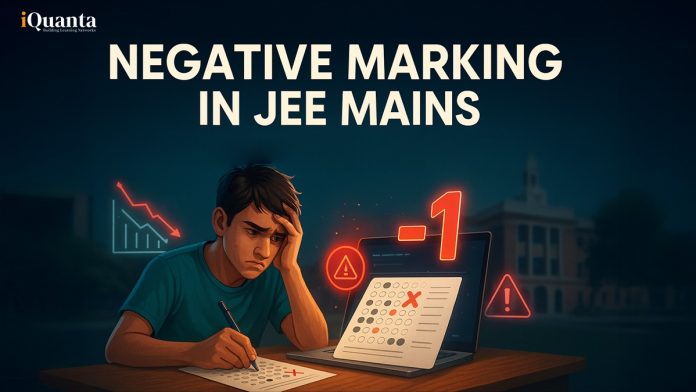JEE Main 2025 exam pattern includes important details about negative marking in JEE Mains, has been released by NTA on its official website- jeemain.nta.ac.in. The information bulletin outlines critical aspects like the total number of questions, marking scheme, exam duration, subject-wise weightage, and total marks.
As per the updated JEE Main 2026 pattern, the exam will consist of 75 questions- 25 each from Physics, Chemistry, and Mathematics- with a total of 300 marks. Candidates are strongly advised to thoroughly understand the marking scheme, especially negative marking system, as it plays an important role in overall performance and rank. Let us learn more!

Join this free JEE Prep Group to Get Free Study Material, Preparation Strategy by Toppers, Latest Updates and More!
Is there any Negative Marking in JEE Main 2026?
Yes, negative marking is applicable in JEE Main 2026. As per the official exam pattern released by the National Testing Agency (NTA), each question carries a total of 4 marks. Candidates will be awarded +4 marks for every correct answer. However, one mark will be deducted from the total score for every incorrect answer.
It’s important to note that if a candidate leaves a question unattempted, they will not receive or lose any marks for that question- the score remains unchanged.
This negative marking system applies specifically to multiple-choice questions (MCQs). For numerical value-type questions, there may or may not be negative marking depending on the updated instructions for the exam year, so it’s important to check the official bulletin for those specifics.
JEE Mains 2026 Marking Scheme Overview
| Response Type | Marks Awarded | Marks Deducted | Final Impact |
| Correct Answer | +4 | 0 | Adds 4 marks |
| Incorrect Answer (MCQs) | 0 | -1 | Deducts 1 mark |
| Unattempted Question | 0 | 0 | No marks awarded/deducted |
| Numerical Value Questions | +4 (if correct) | -1* (if applicable) | Depends on instructions |
Note: Negative marking for numerical questions depends on the official NTA guidelines for a specific year.
JEE Main Exam Pattern 2026 (Revised)
JEE Main Exam Pattern 2025 for Paper 1 (B.E./B.Tech)
75 questions will be asked in the JEE Main 2025 Paper 1 for BE/B. Tech program. The question paper will consist of 25 questions each from Physics, Chemistry, and Mathematics:
| Subjects | Section A (MCQs) | Section B (Numerical) | Total Marks |
| Mathematics | 20 | 5 | 100 |
| Physics | 20 | 5 | 100 |
| Chemistry | 20 | 5 | 100 |
| Total | 60 Questions | 15 Questions | 300 Marks |
JEE Main Exam Pattern 2025 for Paper 2A (B.Arch)
Candidates can refer to the JEE Main 2025 exam pattern for Paper 2A (B.Arch) in the table below. The B.Arch paper will consist of a total of 77 questions, including two questions in drawing section.
| Subjects | Number of Questions | Marks |
| Mathematics | 25 (20 MCQs + 5 Numerical Value Questions) | 100 |
| Aptitude | 50 | 200 |
| Drawing Test | 2 | 100 |
| Total | 77 Questions | 400 Marks |
JEE Main Exam Pattern for Paper 2B (B.Planning)
A comprehensive overview of JEE Main 2025 exam pattern for Paper 2B (B.Planning) is provided in the table below. The question paper will consist of a total 100 questions, with the planning section comprising 25 questions.
| Subjects | Number of Questions | Marks |
| Mathematics | 25 (20 MCQs + 5 Numerical Value Questions) | 100 |
| Aptitude | 50 | 200 |
| Planning Test | 25 | 100 |
| Total | 100 Questions | 400 Marks |
To determine the negative marking in JEE Main 2025, substract 1 mark for each incorrect answer, which is one- fourth of the marks awarded for a correct response. For every correct answer, you earn +4 marks, while each wrong answer results in a deduction of 1 mark.
Strategies To Avoid Negative Marking in JEE Main 2026
| Strategy | Description |
| Read the Questions Carefully | Misreading or misinterpreting questions can lead to mistakes. Carefully reading ensures understanding of the requirement and reduces careless errors, helping minimize negative marks. |
| Use the Elimination Method | Rule out incorrect options to narrow down choices. Apply logic and subject knowledge to increase the chances of selecting the correct answer and avoid wild guessing. |
| Be Confident & Stick to Answer | Once an answer is selected, avoid changing it unless necessary. Second-guessing without reason may result in incorrect answers and unnecessary negative marks. |
| Practice & Time Management | Regular practice enhances familiarity with concepts, improves accuracy, and boosts confidence. Time management during the exam helps avoid rushed decisions and unnecessary errors. |
| Avoid Guesswork | Blind guessing often leads to incorrect answers. Only make educated guesses when at least one or more incorrect options can be confidently eliminated, increasing the probability of choosing the correct answer. |
| Use Contextual Clues | Use hints or contextual information given in the question, especially in numerical or reasoning problems, to guide your answer choices and make better-informed decisions. |
| Prioritize Confident Questions | Focus on answering the questions you’re most confident about first. This ensures you maximize correct answers before spending time on uncertain or complex questions. |
| Avoid Last-Minute Rushing | Rushing in the final minutes often leads to misreading questions and mistakes. Allocate buffer time for revision or to double-check flagged questions. |
| Understand Marking Scheme | Be fully aware of the marking scheme: +4 for correct answers and -1 for incorrect ones. This knowledge helps you decide whether a question is worth attempting if you are uncertain. |
| Simulate Real Test Conditions | Take mock tests under real exam conditions to improve speed and accuracy. This reduces panic during the actual exam and familiarizes you with the pressure of time-bound answering without random guessing. |
JEE Main 2025 Preparation Tips
| Preparation Tip | Description |
| Understand the Exam Pattern | Familiarize yourself with the JEE Main 2025 format, including the number of questions, marking scheme, and negative marking in JEE Mains. This helps you plan your answering strategy effectively. |
| Follow the Syllabus | Stick closely to the official JEE Main syllabus, covering all key topics in Physics, Chemistry, and Mathematics. Focus on high-weightage areas for better results. |
| Practice with Previous Papers | Solving past question papers gives insight into recurring question types and difficulty levels. It also helps reduce mistakes that could lead to negative marking in JEE Mains. |
| Take Mock Tests | Attempt mock exams in a timed setting to simulate real test pressure. This improves speed, accuracy, and helps you avoid careless errors that might result in negative marking. |
| Strengthen Concepts | Develop a deep understanding of concepts instead of rote learning. Strong basics will help answer application-based questions correctly and avoid negative marking. |
| Time Management | Learn to manage time wisely during the exam. Attempt easier questions first, skip tough ones initially, and come back later to minimize errors and reduce negative marking risks. |
| Revise Regularly | Consistent revision boosts memory retention and improves confidence. Allocate time weekly for reviewing key formulas and topics. |
| Stay Updated | Keep track of updates from the official NTA website about changes in exam pattern, eligibility, or rules related to negative marking in JEE Mains. |
Click Here to Enroll to JEE 2026 Course!

Frequently Asked Questions
Yes, there is negative marking in JEE Main. For each correct answer, candidates earn 4 marks, while 1 mark is deducted for every incorrect response. No marks are awarded or deducted for unanswered questions. Understanding this marking scheme is crucial to avoid losing marks due to guesswork or careless errors.
JEE Main Paper 1 is of 300 marks, not 360. It includes 75 questions—25 each from Physics, Chemistry, and Mathematics—with 4 marks for each correct answer.
In a 1/4 negative marking scheme, one-fourth of the total marks for a correct answer are subtracted for every incorrect response. So, if a question is worth 4 marks, 1 mark is deducted for each wrong answer.




